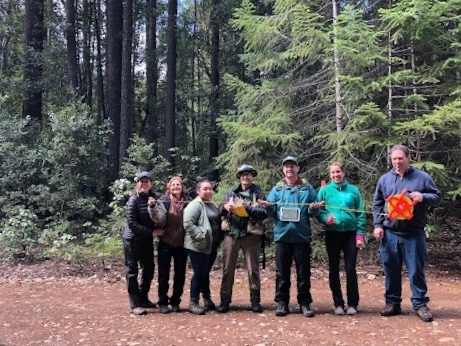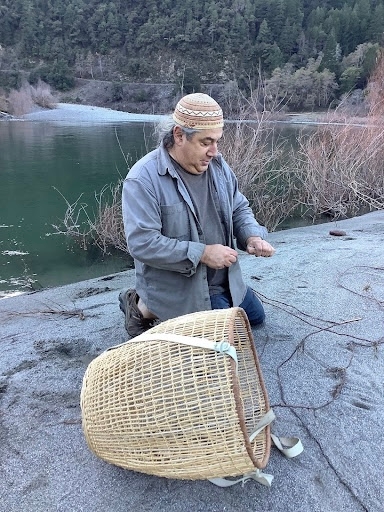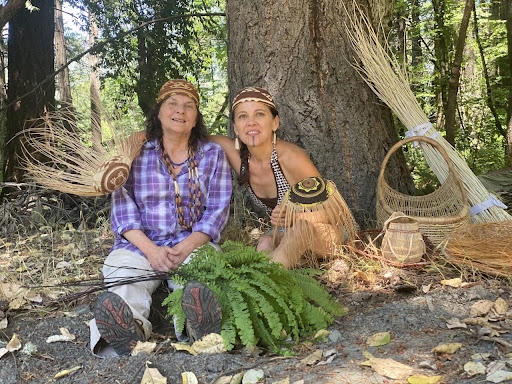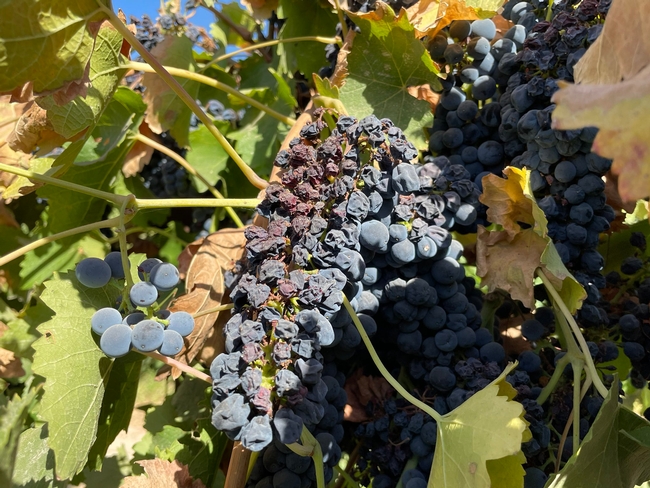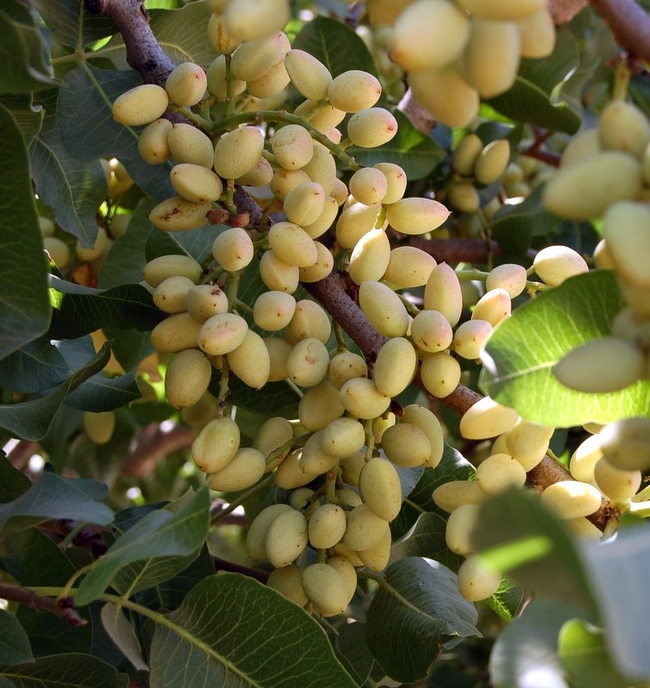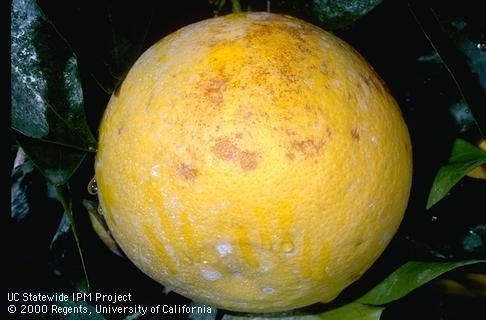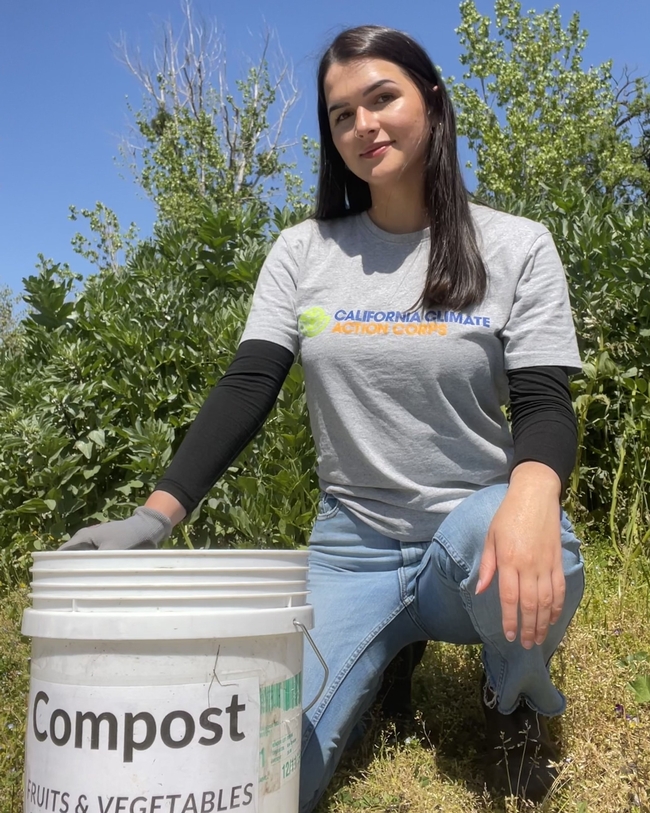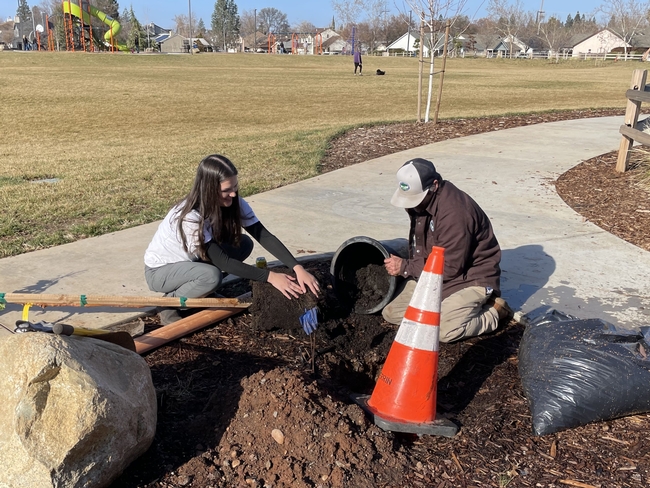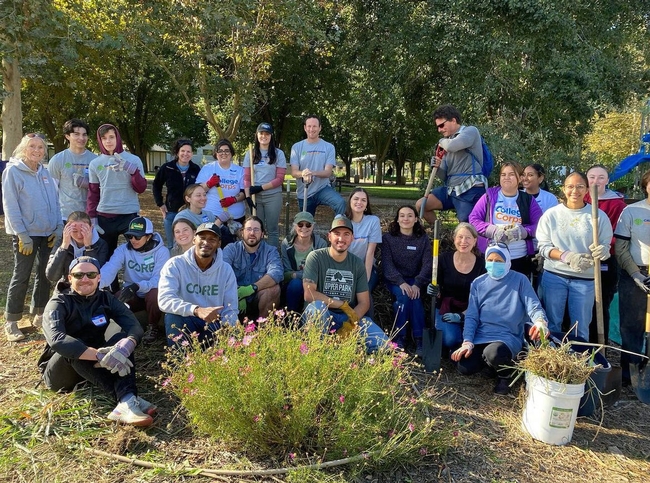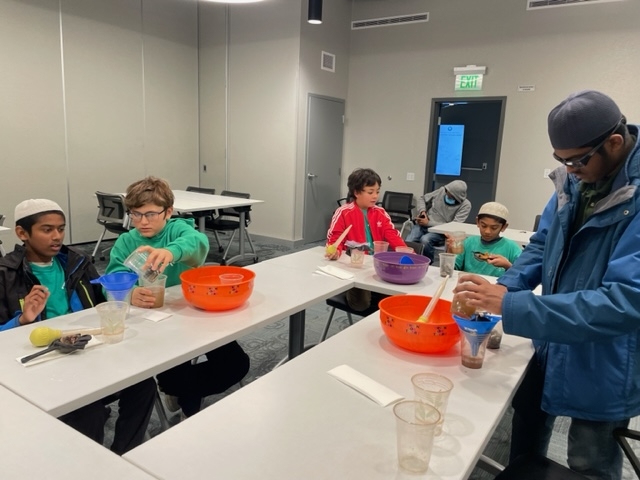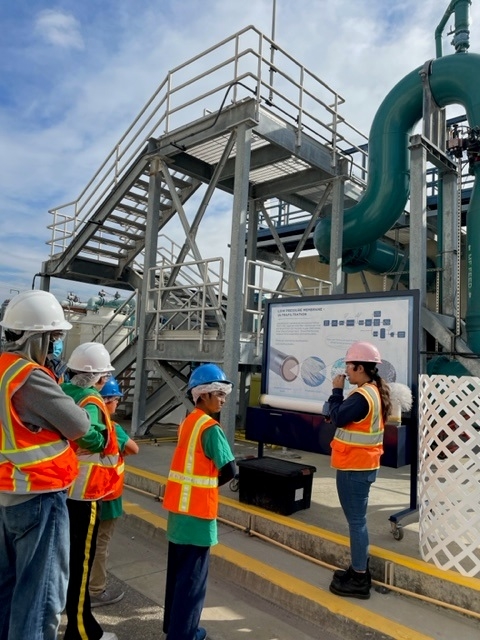Posts Tagged: climate change
Residents’ water security concerns could spur climate adaptations
Study: Climate impacts widespread across California, fueling worries over water supply
As water system managers across California devise strategies to help secure their water supply, they often face a major obstacle to implementing those measures: a lack of interest or will to act among community members.
“One of the things that the literature has found is that even if water system managers and local decisionmakers are really worried about climate change and water security, a lot of the adaptation strategies that they have in their toolbox actually require support from residents,” said Kristin Dobbin, a UC Cooperative Extension specialist focused on water justice planning and policy.
Because popular support is essential for realizing many water-related adaptations – from changing the rate structure to approving bonds for new infrastructure – Dobbin and her colleagues recently published a paper looking deeper at residents' experiences of, and concern about, climate impacts to household water supply.
Through a drinking water-focused portion of a long-term panel survey administered by California State University, Sacramento, scholars in the Household Water Insecurity Experiences research network had the opportunity to query Californians on how they are experiencing the climate crisis at their taps. Specifically, the researchers sought to analyze respondents' perceptions of future climate risks to water security.
“As a group that studies drinking water access in California, we're often looking at the system level and community level,” said Dobbin, based at the UC Berkeley Department of Environmental Science, Policy and Management. “So it was exciting to dive into the household level and understand what's happening at a more individual level.”
Climate impacts seen ‘up and down the state'
The statewide survey, conducted in spring 2021, elicited 704 responses from the panelists, representing every census region in the state and nearly every county. More than one-third (34%) of respondents said that their water supply had been affected by an extreme weather event in the past five years. Given the timing of the survey, drought was unsurprisingly the most frequently mentioned impact. Importantly, these climate impacts were felt across California.
“There is an inclination to assume that drought and other impacts are a geographically bounded issue, but what we really see is that is not the case,” Dobbin said. “These impacts are happening up and down the state, all the way to the Oregon border.”
Overall, 85% of respondents reported that they were concerned about the long-term reliability of their water supply. Crucially, the study also indicated that residents were making the connection between climate impacts and risks to their future water security.
“The more impacts they reported, the more concerned they were about future supply and reliability,” said study co-author Amanda Fencl, a senior climate scientist with the Union of Concerned Scientists.
Droughts and heat waves, in particular, seem to increase residents' concerns over water supply the most. Dobbin suggests that framing the need for water-security adaptation strategies around those specific weather events could be particularly useful in marshaling community support.
Knowing the level of concern within the community – and understanding the best way to convey the urgency of climate adaptation measures – could be a boon for local managers seeking to gain public backing for more expensive water projects. Such projects might include self-sufficiency measures that reduce reliance on imported water from other parts of the state.
“That could bolster some water managers to have more confidence in using climate change and extreme events as a way to motivate ratepayers to get on board with these bigger investment decisions,” Fencl said.
Study highlights avenues for more research
While flooding barely registered as a climate impact in the 2021 survey results, Dobbin said that the responses would likely be very different today, after atmospheric rivers inundated the state this past winter. Floodwaters can damage water treatment plants – and storms can knock out power to private wells and larger water system treatment and distribution facilities.
In fact, from the 2021 survey, power outages due to utilities' wildfire prevention policies were the climate impact most frequently mentioned in the “other” category, highlighting for researchers the need to consider and plan for the interconnectedness of water and power systems.
“People forget about the interplay between a reliable electric grid and the ability to run water in your house and the ability for water systems to pump and treat water,” Fencl explained. “When we think about disaster response and disaster preparedness, we need to be a bit more holistic.”
The researchers also pointed to significant differences in experiences of climate impacts across gender and racial demographics, with Latino, Asian American Pacific Islander and LGBTQ+ respondents reporting higher rates of impacts. Given the relatively small sample sizes, however, Fencl said there needs to be larger – and more inclusive – surveys to get a clearer picture of those disproportionate impacts.
Even still, Dobbin added that their study serves as a reminder for scholars, water managers and policymakers to re-center community members, in all their diversity, as key players in the push for more effective and sustainable climate adaptation strategies.
“One of the takeaways from the paper is that we can't forget about the role of the public in this conversation – and we can't bypass the public,” Dobbin said. “The bottom line is that most of the adaptations that we have available to us require some level of residential involvement.”
In addition to Dobbin and Fencl, authors of the study, published in the journal Climatic Change, include Gregory Pierce, UCLA Luskin Center for Innovation; Melissa Beresford, San Jose State University; Silvia Gonzalez, UCLA Latino Policy and Politics Institute; and Wendy Jepson, Texas A&M University.
Indigenous science key to adapting to climate change
UC Berkeley and Karuk Tribe use Indigenous and western science to cultivate resilient food systems under changing climate conditions.
To adapt to climate change, Karuk Tribe members identified the importance of monitoring climate stress on plant species and actively managing and restoring healthy ecosystem processes to increase the consistency and quality of their food harvests, according to a new report. The Karuk Tribe's Aboriginal Territory encompasses over a million acres in the Klamath Basin in Northern California and Southern Oregon.
The Karuk Tribe-UC Berkeley Collaborative has released findings from its four-year collaborative research in their report “Karuk Agroecosystem Resilience and Cultural Foods and Fibers Revitalization Initiative: xúus nu'éethti – we are caring for it.”
To assess climate-change impacts on cultural-use plants and their habitats and to develop strategies and tools for long-term monitoring, this project integrated Indigenous and western science perspectives.
“Understanding the breadth and intensity of climate change with regard to our cultural resources is key to developing adequate response plans,” said Karuk cultural practitioner and project co-lead Lisa Morehead-Hillman. “Without healthy stands (of trees), our cultural practices suffer. We all suffer.”
The report authors lay out specific place-based management and monitoring actions that will enhance the resilience of cultural focal species and habitats to climate change, climate variability and management threats.
To support the resilience of Indigenous cultural agroecosystems and cultural food and fiber species, as well as strengthening Indigenous food sovereignty now and into the future, the authors recommend the following management, policy, research and institutional actions:
• Supporting Karuk Tribal natural resource, data and knowledge sovereignty through appropriate engagement and Tribal oversight.
• Investing in Tribal management infrastructure and workforce development to support culturally appropriate, place-based job opportunities for Tribal members and descendants.
• Supporting co-management and family-based stewardship of cultural use plants and habitats on Karuk Aboriginal lands.
• Investing in and supporting the re-acquisition of Karuk Aboriginal lands to build back the Tribal land base and restore habitats and ecosystems.
• Funding research, monitoring, and educational opportunities that can support youth leadership development, job creation, agroecosystem resilience, and food sovereignty in Karuk Aboriginal Territory.
This research builds on the findings from a five-year Karuk Tribe-UC Berkeley Collaborative food security project (2012-2018), which found that 92% of all Tribal households in the Klamath River Basin experienced some level of food insecurity, and that having access to cultural foods was a strong predictor of food security, yet only 7% of all Tribal households had access to good quality cultural foods at all times.
“This project applies what we learned from tribal members about food insecurity and climate and land management threats to cultural foods to the landscape level, co-creating methods and tools with our Karuk colleagues to assess and restore the health, quality and abundance of cultural foods and fibers to promote food security and eco-cultural resilience,” said Jennifer Sowerwine, lead UC Berkeley collaborator and associate professor of Cooperative Extension.
Research objectives centered around the “Agroecosystem Condition Assessment,” in which UC Berkeley and Karuk researchers and cultural practitioners assessed the health, quality and yield of 20 cultural-use focal plants prioritized by the Karuk Tribe, such as tanoak acorns, evergreen huckleberry, bear grass and hazel, as well as the condition of their habitats.
“This project demonstrates the benefits of working with a diverse research partnership in the co-production of climate science using blended Indigenous and Western research and monitoring methods,” said project collaborator Frank Lake, research ecologist and USDA Forest Service Pacific Southwest tribal liaison. “This project exemplifies recent federal directives and initiatives to support tribes for climate adaptation, forest restoration and eco-cultural revitalization.”
The overall quality and condition of most of the focal species found in the research plots and patches reflect both the devastating impact of colonial land-management practices – including timber harvest, fire exclusion and mining – as well as clear evidence of climate stress such as aborted fruit, early die back and poor-quality product. Forced exclusion of cultural management is reflected in encroachment of invasive species, inappropriate canopy cover and poor-quality harvests impacting both human and animal access to these important plant resources.
“This work done among Indigenous knowledge holders and academia is paramount to developing and sustaining a well-trained workforce for the future,” said Bill Tripp, director of the Karuk Tribe Department of Natural Resources and project co-lead. “We have a long way to go in realizing cultural relevancy in addressing the systemic injustices that plague our people, accelerate climate change, and work against ecosystem process and function.”
Based on research findings informed by the deep insights of Karuk natural resources managers, Karuk elders and cultural practitioners, the report outlines recommendations for restoring key habitats and revitalizing culturally significant species to enhance agroecological resilience in Karuk Aboriginal lands, which are concurrently administered, managed and occupied by U.S. Forest Service and private landowners.
Kathy McCovey, a Karuk cultural practitioner, archaeologist, forest ecologist and project collaborator, explained the cultural significance of the project:
“Through this project, we are learning how to reconnect with place,” McCovey said. “In learning about and tending these areas, we are tending our family gardens. It's all about people in place. Working on this project, we are working to bring these places back to life. We're rediscovering their Karuk names and how those names signal traditional uses of plants in those places. That way we can reconnect with the places our families come from”.
“The whole river system is full of knowledge,” she elaborated. “It's a crucial time for the Karuk people to tend these areas and learn how to take care of them. This community has knowledge that's developed and evolved with these lands and we have a responsibility to support the plants in these areas. We had our land stolen out from under us, but we still live here, we still know how to tend and gather plants, we still have our knowledge and our ceremonies. We still have the ability to go out and gather from the land. We still know how to take care of this place. We take care of the land and it takes care of us.”
This project serves as an example of how university and federal agency researchers can partner with California tribes to lift up Indigenous knowledge, which can help all involved to better understand and develop solutions to the climate crisis and its effects on California's landscapes and biodiversity, especially on species of cultural significance to Indigenous communities.
Funding for the project was provided by a grant from the USDA NIFA Agriculture and Food Research Initiative Resilient Agroecosystems under Changing Climate Challenge Area.
Download the free report at the Karuk-Berkeley Collaborative website: https://nature.berkeley.edu/karuk-collaborative/wp-content/uploads/2023/03/Karuk-Resilience-Report_Smallest-file-size.pdf
Key climate data added to enhance grower decision-support tool
Free CalAgroClimate tool helps growers protect crops from frost and extreme heat
California farmers can see how climatic conditions that may affect agriculture are changing in their regions by using CalAgroClimate so they can make strategic changes. Nine new agriculturally important climate indicatorshave been added to the decision-support tool created by UC Cooperative Extension and U.S. Department of Agriculture scientists.
These new tools use a high-resolution climate dataset called PRISM to provide location-specific or county-aggregated long-term trends in agroclimatic indicators from 1980 to last year. These new agroclimate indicators include Frost Days, Last Spring Freeze, First Fall Freeze, Freeze-Free Season, Tropical Nights, Hot Days, Extreme Heat Days, Heatwaves and Diurnal Temperature Range (see definitions below). These indicators were derived from a study published in the journal Agronomy.
All of the new tools are free and available on CalAgroClimate for anyone to access.
“Frost-related tools such as Frost Days, Last Spring Freeze, First Fall Freeze, and Freeze-Free Season can help farmers and agricultural clientele make informed long-term choices,” said Tapan B. Pathak, UC Cooperative Extension specialist in climate adaptation in agriculture based at UC Merced, who is leading the CalAgroClimate project.
“For instance, if you are planning to invest in a frost sensitive crop in your region, these indicators can provide valuable information on whether frost risk has changed over time and whether it is less risky to make such an investment,” he said. “Wine grapes, for instance, are very sensitive to frost. Although not all frost events are damaging, understanding long-term trends in frost can help in making long-term strategic decisions such as whether to invest in frost protections.”
Another set of new agroclimatic indicators, on CalAgroClimate – Tropical Nights, Hot Days, Extreme Heat Days, Heatwaves and Diurnal Temperature Range – are based on higher maximum and minimum temperatures. Tropical Nights, for instance, calculates total number of nights when overnight temperatures exceed 68 F. More frequent tropical nights can increase crop respiration rates and can be detrimental for fruit quality and quantity, increase the risk of damage from pathogens, and potentially impact fruit set and yield.
Knowing how trends are evolving over time can assist growers in managing their crops to reduce risks. Similarly, growers can easily look at trends related to heat – hot days, extreme heat and heatwaves – on CalAgroClimate to assess their options on what they need to do to be adaptive. In the short term, growers may put up shade or for longer term, choose varieties that are more heat-tolerant.
“In recently published work, one of the farmers in the Central Valley told us, ‘When you really see so much difference in a short amount of time in your immediate area…we would have to look at that and say, well, we're going to have to adapt varieties because this is a 20- or 25-year planting and we're going to have to find crops or varieties that will adapt to that,'” Pathak said.
Another farmer told us, “Knowing what's going to happen or at least having a good idea, if you know something's going to be become or won't be viable, then obviously you're going to try to phase that out, and phase in something that's better suited.”
Pathak added, “The new agroclimatic indicators on CalAgroClimate provide a reality check on how conditions are changing in short and long-term, what it means for farmers and to assist them on deciding what they need to do to be adaptive. These tools will greatly benefit farmers and agricultural clientele in assessing risks and making informed decisions.”
Other collaborators include StevenOstoja and Lauren Parker of theUSDA California Climate Hub,PrakashKumarJha of UC Agriculture and Natural Resources and Robert Johnson and ShaneFeirer of UC Agriculture and Natural Resources' Informatics and Geographic Information Systems.
Definitions of AgroClimatic Indicators:
Frost Days are days in a year with minimum temperature below or equal to 32F.
Last Spring Freeze is the latest day in spring when minimum temperature is below or equal to 32F.
First Fall Freeze is the earliest day in fall when minimum temperature falls to 32F or below.
Freeze-Free Season is the time between the last spring and first fall freeze, represented by the number of consecutive days in a year without freezing temperatures.
Tropical Nights are number of nights when temperatures exceed 68F.
Hot Days are the days per year with maximum temperature exceeding 100 °F.
Extreme Heat Days are the number of days per year with maximum temperatures warmer than the 98th percentile of historical summer maximum temperature for the selected location.
Heatwaves are events that occur when extreme heat lasts for at least three consecutive days.
Diurnal Temperature Range is the difference between daily maximum and minimum temperatures.
UC Climate Steward: ‘It’s the most fulfilling work’
Climate Stewards course instructor inspires change in Butte County
Growing up in Butte County, Rose Brazil-Few has watched climate change devastate communities and ecosystems in the form of severe drought and deadly wildfire, including the 2018 Camp Fire that swept through Paradise. Through the University of California Climate Stewards program, Brazil-Few is taking action in her home county – and inspiring others to help.
“Seeing the environmental situation firsthand in California, every day I find a reason to work on climate action projects,” she explained. “It's the most fulfilling work that I could possibly be doing right now.”
As a California Climate Action Corps Fellow (a workforce development program affiliated with California Volunteers), Brazil-Few is working at the Butte Environmental Council as community sustainability coordinator. She said the UC Climate Stewards course she completed last fall – administered by the UC California Naturalist program – taught her crucial lessons she applies every day, especially on framing and conveying the climate crisis.
“One of the biggest takeaways is how to communicate about climate change while we're doing climate action work,” she said. “Sometimes you encounter community members who don't necessarily like the term ‘climate change,' but they still believe in cleaning up parks and planting trees for shade – so focusing on positive action will still accomplish your bigger goals.”
Brazil-Few will further amplify those locally rooted solutions and climate stewardship opportunities when she starts teaching her own UC Climate Stewards course this summer, through Butte Environmental Council.
“Rose is the first CCAC fellow to become a certified Climate Stewards course instructor as part of the Pathway to Leadership we co-developed with CCAC,” said Sarah-Mae Nelson, UC Climate Stewards academic coordinator. “This pathway is an opportunity for fellows to continue fostering community and ecosystem resilience in their communities as active Climate Stewards, once their official fellowship has ended.”
Since launching in fall 2020, nearly 500 people have completed the UC Climate Stewards course, which is delivered by 17 partner organizations throughout the state. Nelson noted that, in addition to the CCAC collaboration, UC Climate Stewards is also working with Sustainability Service Corps and SEI (Strategic Energy Innovations) Climate Corps – and looking into bringing the course to other states.
A 2021 graduate of Humboldt State University with a bachelor's degree in environmental studies, Brazil-Few said she appreciates that the UC Climate Stewards course instills a sense of hope and empowerment and possibility.
“I know some people who feel hopeless because there's such a focus on the doom of climate change – when in reality you can find so many programs and people in your local community making positive change,” she said.
In her community, Brazil-Few highlights the partnership efforts between the Butte County Local Food Network and area growers, the Traditional Ecological Knowledge sharing at Verbena Fields in Chico, and the continued growth of the community composting program – among many other projects.
They all illustrate a key point that Brazil-Few will emphasize as she designs her UC Climate Stewards course: a meaningful climate project need not take place at a large scale – action can happen, literally, in one's own backyard.
“It can be easily attainable and accessible,” she said. “And just talking about it with people and getting your community excited is the very first step in creating a series of events that eventually leads to a bigger impact on climate change and positive environmentalism.”
Los Angeles 4-H program cultivates future generation of water stewards
Ibrahim Yaaseen, member of the Palos Verdes Peninsula (PVP) 4-H club, grabs a hard hat and places it on top of his head. He then reaches for a bright orange safety vest and goggles to complete his safety gear outfit before joining the rest of his club members who are dressed the same.
The 4-H Youth Development Program of Los Angeles is already thinking about the future of water management and turned to the West Basin Municipal Water District in El Segundo to gain a deeper understanding of the precious resource we often take for granted.
The University of California 4-H Youth Development Program is managed through local Cooperative Extension offices. Through hands-on learning experiences, 4-H empowers youth to reach their full potential and enables them to build self-esteem, connect with their community and emerge as leaders.
Dee Keese, community club leader for the PVP 4-H club, coordinated an exclusive and interactive tour of West Basin's Edward C. Little Water Recycling Facility for the club's monthly marine biology meeting in December 2022.
Eager to inspire a stronger appreciation for water, Janel Ancayan, the West Basin's education coordinator, challenged the youth to build their own water filters using materials including fabric, a strainer, and a funnel. Since no specific directions were given, the activity challenged each student's science and engineering skills, such as carrying out an investigation, designing a solution, and communicating information with team members.
During the tour, students saw firsthand the impressive equipment and essential staff members that help to produce nearly 40 million gallons of recycled water each day. At the end of the day, students left with a deeper understanding of water resources and felt empowered to do their part to conserve water sources.
“We learned that recycling water helps to conserve our limited water supply and improves the environmental condition of our coastal waters,” said Yaaseen. “We ultimately learned a great deal about how to conserve water for future generations and that water conservation is one of the most important elements in combating climate change.”
Though Keese has volunteered as community club leader for 48 years, this is only the second time she has partnered with the West Basin. “I like to mix it up,” she said. “I'm always looking for community organizations and local businesses to partner with because these are places that the kids will likely interact with since they're nearby.”
Regardless, it's leaders like Keese and programs like 4-H that encourage water stewards like Ancayan. “I'm always so humbled and inspired when teachers make it a point to come out and visit our facility. In Southern California especially, [water] is not something we think about,” Ancayan said.
Even in a drought, water continues to flow from our faucets allowing us to shower, wash dishes or water the lawn. It's no wonder why water conservation is not always top of mind, especially for consumers. Educating the public, and targeting the younger generation, however, is a great start to prepare for the future.
West Basin offers a variety of educational programs that focus on different age groups. Many of them involve hands-on learning like the Teach and Test volunteer program, a partnership with the Surfrider Foundation, where high school students test samples of coastal water for bacteria, and then publicly share their findings to contribute to water quality monitoring in the area.
According to Yaaseen, the time spent with Ancayan at the West Basin was “one-of-a-kind” and provided a “golden opportunity” to learn why water recycling facilities are important. Ancayan hopes that her time spent with students ultimately influences them to consider a career in water.
“It's not a glamorous job but I'm really passionate about the next generation of water workers,” she said. “I hope that once they see the engineering, the excitement of these scientists that work in our laboratory and everything in between, that they start to think about water as a future career path.”
For those interested in joining 4-H, visit https://4h.ucanr.edu/Members/
To read this story in Spanish, please visit:
Programas 4-H de Los Ángeles forman a la futura generación de administradores de los recursos hídricos
https://ucanr.edu/blogs/blogcore/postdetail.cfm?postnum=57063


